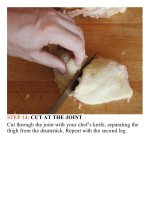The food lab better home cooking through science ( PDFDrive ) 955
Bạn đang xem bản rút gọn của tài liệu. Xem và tải ngay bản đầy đủ của tài liệu tại đây (151.03 KB, 2 trang )
easilymixtoformahomogeneousmixture.Incooking,this
mostoftenoccurswithoilandwater(and,forallintentsand
purposes, vinegar or lemon juice can be considered water,
as they behave in the same way). You can put them in a
containertogetherandstirthemup,buteventually,likecats
and dogs, they will separate and stick with their own kind.
There are a couple of ways around this. The first is to
disperse one of the two—the oil, say—into fine-enough
droplets that water can completely surround them. Kind of
like putting a single cat inside a ring of dogs—there’s no
wayforittoescapeandrejoinitsfelinefriends.Acommon
example of this kind of emulsion is homogenized milk, in
which whole milk is forced at high pressure through a fine
screen,breakingupitsfatmoleculesintoindividualdroplets
thataresuspendedinthewaterywhey.Thisiscalledanoilin-water emulsion, because the fat molecules are separated
and completely surrounded by water molecules. Most
familiar culinary emulsions are of this type, the most
common exception being butter, which is a water-in-oil
emulsion: tiny drops of water are completely suspended in
butterfat (of course, once you incorporate that butter into a
hollandaise sauce, you’ve converted it into an oil-in-water
emulsion;seehereformoreonhollandaise).
Simply mixing oil and vinegar forms an extremely
unstable emulsion—no matter how thoroughly you mix
them, no matter how much you separate the oil molecules,
eventually they regroup and your emulsion will break. In
order to form a stable emulsion, you need to add an
emulsifyingagentknownasasurfactant.
Remember that cartoon CatDog?The one with the head
of a cat on one end and the head of a dog on the other?
Well,CatDogiskindoflikeasurfactant:he’sgotsomething
that’s attractive to both catsand dogs, which makes him a
kind of feline-canine ambassador, allowing the two to mix
together a little more easily. Culinary surfactants are
molecules that have one end that is attractive to water
(hydrophilic)andonethatisattractivetooil(hydrophobic).
Common kitchen surfactants include egg yolks, mustard,
and honey, and it’s easy to see the work of a surfactant in
action.
The container on the left contains oil and balsamic vinegar
mixed in a ratio of 3:1.The one on the right has the same
ingredients, with the addition of a small amount of Dijon
mustard.Bothcontainersweresealedandshakenvigorously
until the vinaigrette looked homogeneous. I then allowed
themtorestatroomtemperaturefor5minutes.Asyoucan
see, the vinaigrette without the mustard separated much
morerapidlythantheonewithmustard.
Atthispoint,you’reprobablythinkingwhatI’mthinking:
thisisallveryneat,butwhatdifferencedoesitmaketomy
salad?Goodquestion.









